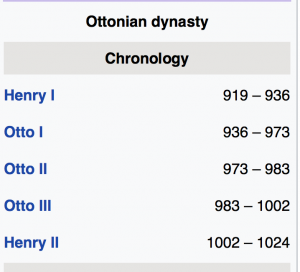WEEK 6
In the period after the death of Charlemagne in 814, the successive generations of his sons and grandsons were unable to hold the empire together. Similar territories within the Roman Empire had required hundreds of years to become well integrated into an international empire. And the Carolingians had tried to do it all in just three. In the next 200 years, the slow disintegration produced a myriad of small states, dukedoms, bishoprics etc. that developed their own histories and institutions. For 200 years there wsa no unity and no one dominant German family. Then in the late 900s, the Ottonians emerged. The Ottonian dynasty (German: Ottonen) was a Saxon dynasty of German monarchs(919–1024), named after three of its kings and Holy Roman Emperors named Otto, especially its first Emperor Otto I. It is also known as the Saxon dynasty after the family's origin in the German duchy of Saxony. When this very strong new dynasty of the Ottonians emerged around the late 900s (Otto I, II, III) the choice of the king/emperor had already evolved into an election within which the seven most powerful states chose the next emperor. Therefore, the complex electoral process of choosing the new emperor emerged and remained right to the end of the Empire when Napoleon essentially ended it in 1806.
REQUIRED READING

Steven Ozment,
A Mighty Fortress: A New History of the German People,
Harper Perennial,
ISBN 0060934832

